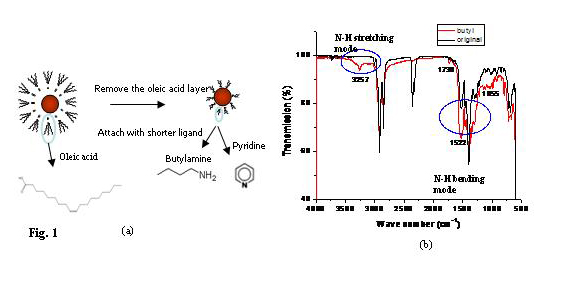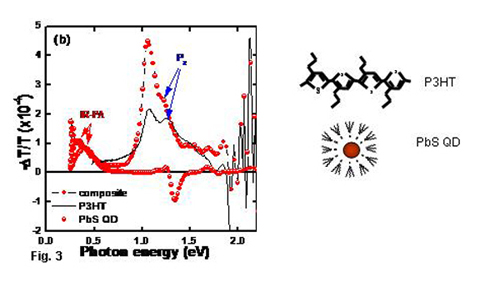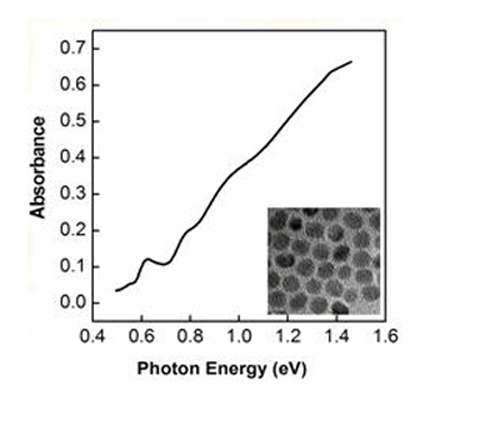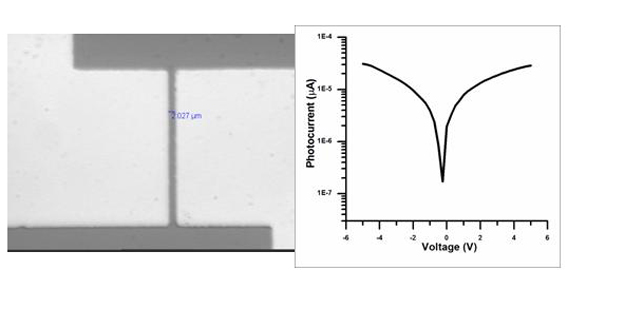Reports: G10
47107-G10 Nanocomposite of Infrared Quantum Dots and Conducting Polymers: Possible Multiple Exciton Dissociation
Objectives:
The goals of the second (last) grant year (08-09) was to continue investigating exciton dissociation process in hybrid PbS/PbSe (QDs) with conducting polymers, as well as how chemical and thermal treatments of QDs affected their optoelectronic properties. Appropriate QD devices were fabricated and characterized. Status of effort:
The second (and last) grant year has seen our multi-tier efforts:
1) Ligands manipulations of PbS and PbSe QDs
Two different ligand manipulations were conducted:
- The first is ligand exchange with butylamine, which is a much shorter ligand than the original oleic acid (Fig. 1a). FTIR spectroscopy confirmed the success of ligand exchange (Fig. 1b).
- The second was ligand removal by Laser Pyrolysis. This part was accomplished through an institutional collaboration with Drs. Mukherjee and Witannachchi. More than three orders of magnitude increase of conductivity of the coupled PbSe QD film with ligands removed by CO2 laser [2] (Fig. 2).
Fig.2. (a) Top view (upper) and cross sectional view (lower) of
a PbSe quantum dots field effect transistor (FET) device on a patterned Si
substrate showing a 2 μm channel. (b) comparison between the conductivity
of the spin-coated film (square) and that of the laser-spay film (triangle).
The inset shows the absorption of the two films, and high resolution
transmission electron micrograph (TEM) image of a 9 nm ligand-free 2) Employing a
spectroscopic measure for exciton dissociation measurements
Based on this unique technology
established last year, we have measured photoinduced absorptions in hybrid film
of ligand-exchanged PbS QDs with conducting polymer P3HT. Enhanced charge
transfer was observed (Fig. 3), indicated by the change of intensity and
position for IR-PA peak.
3). Synthesis and optical
characterization of PbSe QDs
Our group started to
synthesize PbSe QDs using a modified colloidal chemistry procedure through collaboration
with Drs. Witannachchi and Mukherjee's group. As an example, Fig.4
shows an absorption spectrum of 9nm PbSe quantum dots synthesized by us. The insert shows a high resolution
transmission electron micrograph (HRTEM), demonstrating the uniform size
distribution, which is confirmed by the narrow FWHM of the absorption peak at
about 0.65 eV.
Fig. 4
4) Transport
properties study in PbSe QDs
Transport properties
such as mobility and conductivity measurements were carried out in either
lateral (field effect transistor geometry) or sandwich structures.
Methodologies involved Time of Flight and current-voltage characterization. As
an example, Fig. 5 (next page) shows a typical conductivity measurement on a
spin-coated PbSe quantum dot thin film (thickness < 10 nm) on a patterned p+-Si
/SiO2 substrate. The device has a channel length of 2 μm and a
width of 1 mm.
5). Training of
graduate students on special optical characterizations
In addition to Jason Lewis who
was trained on how to fabricate thin film solar cells and necessary
characterization methodologies last year [1], a new
graduate student (Sheng Wu) has been trained on our spectroscopic gauge
measurement employing photoinduced absorption spectroscopy the past year. He
has been involved with this project since he joined my group last fall and has
a paper on the way for submission [4].
Accomplishments/New
findings:
This year's research resulted in
two high-profile journal publications [1,2], and two paper manuscripts being on
the way to submission [3,4]
Interactions/Transitions:
1)
Participation/presentations at meetings, conferences:
·
MRS
2008 Fall Meeting ( ·
Invited
talk at ·
I
have led USF team for a 2009 Global Venture Challenge ( ·
Invited
talk in ACS's 2)
Collaboration/consultation:
Our lab has continued our inter-institutional
collaborations with Dr. Sun's research group in Technical impact:
The results we have
obtained with this grant are important for the continuous research effort on
possible multiple exciton dissociation in hybrid solar cells. Our findings
about photoinduced charge transfer and the unique technique developed to probe it
will help understand the essential process of exciton dissociation and give us
a guideline to achieve high efficiency of the third generation solar cells,
which has immediate impact on the cost-effective utilization of renewable
energy.
Broader impact:
I have always been
grateful for the ACS-PRF grant I received. Not only has it been the major
supporting fund for my beginning years, it has been a tremendous help for my current
grants from New Energy Technology Inc and Florida High Technology Corridor
Fund, through which my group is working on developing transparent SolarWIndow. My PRF It serves as a milestone in my career
development.
References:
1) J. Lewis, J. Zhang and X. Jiang, Fabrication of organic
solar array for applications in microelectromechanical systems, Journal of
Renewable and Sustainable Energy, 1, 1, (2009).
2) G. Dedigamuwa, J. Lewis, J.
Zhang, X. Jiang, P. Mukherjee and S. Witanachchi: A
laser-assisted spray process for the growth of surfactant-free PbSe quantum dot
films, accepted by Appl. Phys. Lett., (2009).
3) Cheng Zhang, Taina Matos, Rui Li, Eric Annih, and
Sam-Shajing Sun; J. Zhang and X. Jiang, Optical and transport
Characterizations of Fully Regioregular Head-to-Tail
Poly(3-Dodedyl-2,5-Thienylenevinylene), submitted, (2009).
4) S. Wu, J. Lewis,
J. Zhang & X. Jiang, Unconventional
Gap State in PbS Quantum Dots, preprint, (2009).









